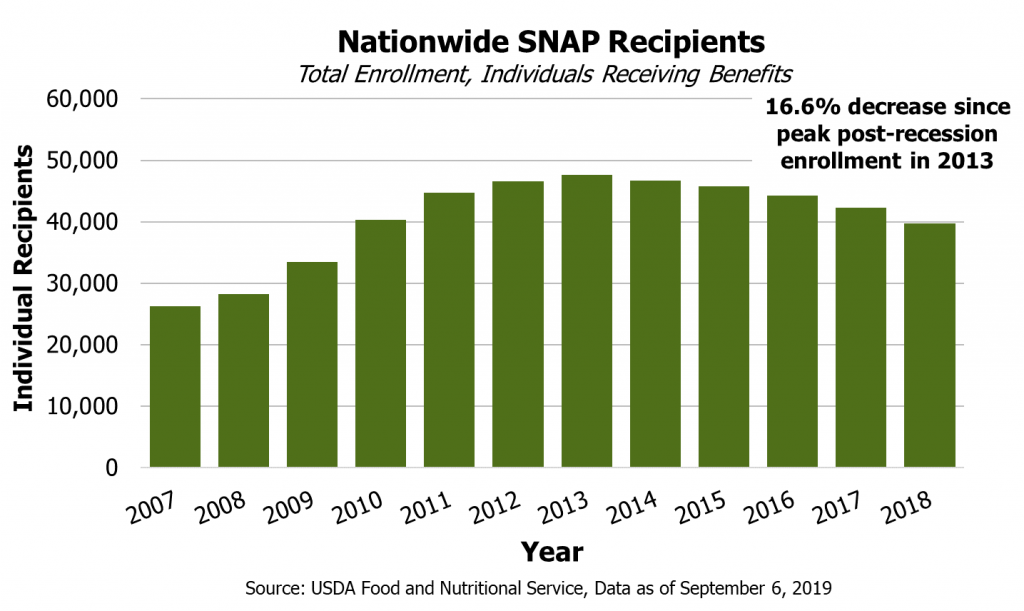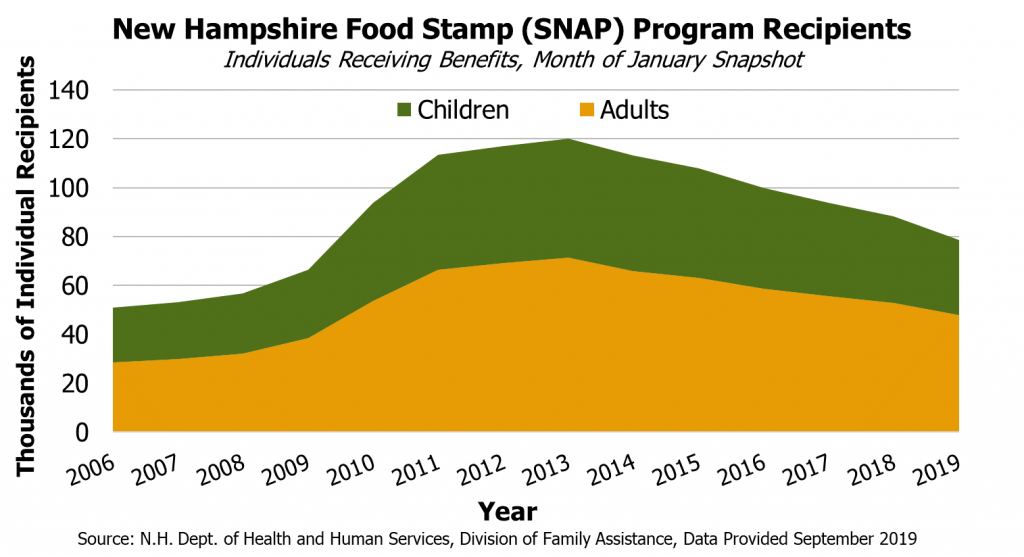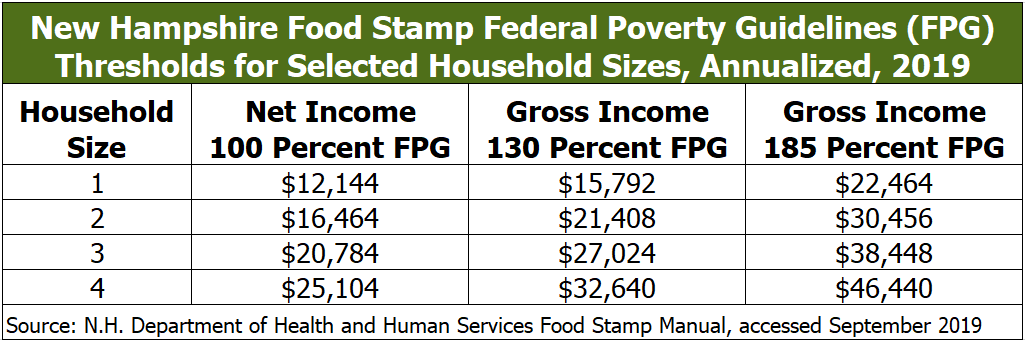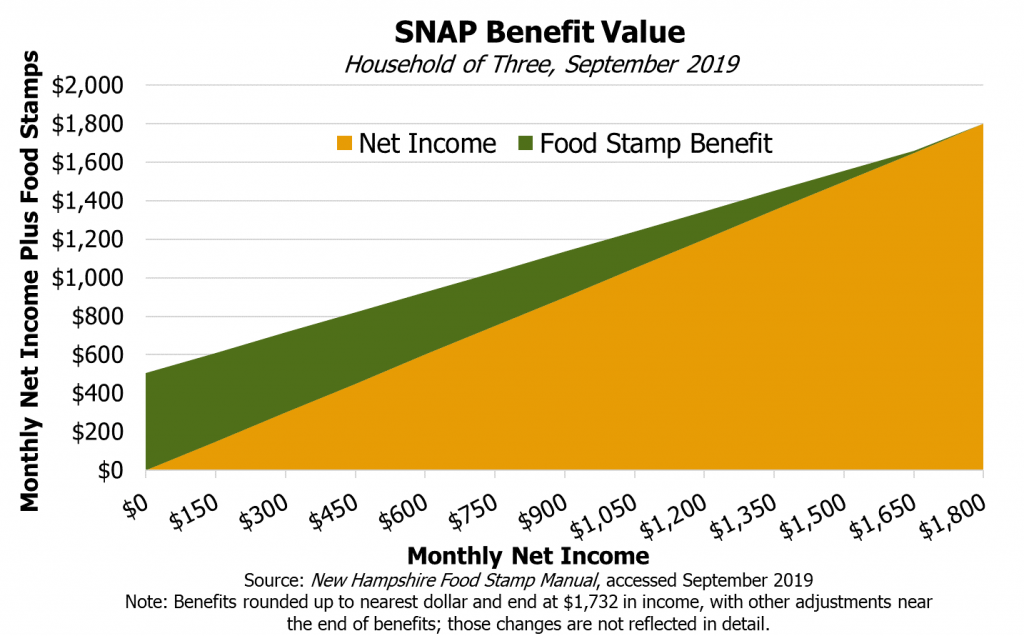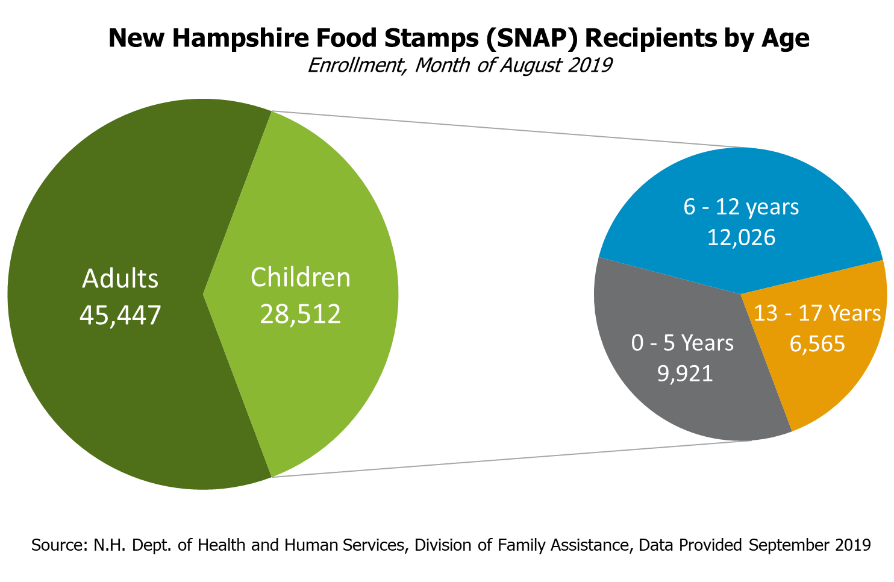The Supplemental Nutrition Assistance Program (SNAP) enhances the ability of individuals and families with low incomes to purchase healthy and nutritious food. This federal program, which is known as the Food Stamp Program in New Hampshire, benefits nearly 40 million people nationwide.[i] Over two-thirds of participants are families with low incomes. The remaining beneficiaries include individuals with low incomes, those with temporary or permanent disabilities, and older adults on fixed-incomes.[ii] About one in eight children across New Hampshire benefit from SNAP, and 73,959 individuals were enrolled as of August 2019.[iii] The main goals of this program are to reduce food insecurity and assist households at or near the poverty line with obtaining healthy and nutritious food.
By design, SNAP is responsive to economic conditions and helps the most vulnerable individuals supplement their food costs. As SNAP is an entitlement program, households in New Hampshire and across the nation that face difficult economic circumstances brought on by recessions, economic shocks, or long-term economic hardship, may be immediately eligible to receive benefits. These benefits provide a stable source of supplemental income specifically for food. National research has shown that SNAP is the most effective anti-hunger program for low-income individuals.[iv],[v]
As part of the partnership between the federal government and states, all expenses for SNAP benefits are covered by the federal government. Approximately half of the administrative costs are paid by the federal government, with the remaining portion of administrative costs covered by each respective state. Depending on income and asset criteria, benefits are distributed based on the size of each eligible household.[vi]
Recently, federal officials have proposed increasing the scope of work requirements mandated in order to receive benefits.[vii] Additionally, proposed policy changes to SNAP eligibility guidelines, which would affect households with children, are being introduced at the federal level.[viii] These changes would make it difficult for many households to access sufficient food. Changes to the eligibility criteria are projected to result in an estimated 3,500 New Hampshire households losing benefits, including up to 18 percent of all New Hampshire SNAP-enrolled households with children.[ix] Research into increased work and eligibility requirements of SNAP beneficiaries have come to similar findings surrounding the effects on individuals and children. Decreases in enrollment are projected if such changes are implemented, at a cost of possibly disenrolling the neediest households and increasing levels of poverty.[x] Children are disproportionately vulnerable to the effects of losing SNAP benefits, as studies have shown food insecurity to be characteristic of decreased development and economic opportunity later in life.[xi]
Decreases in overall enrollment in SNAP since the period immediately following the last recession[xii] is an indicator that the program is responsive to economic conditions and helps lift people out of poverty by supplementing their income for food. Imposing more stringent work and eligibility requirements may subsequently push many needy households off the program, thus reversing the positive trend of decreasing poverty among SNAP recipients across the country and in New Hampshire.[xiii]
The Effects of Food Insecurity
According to the U.S. Department of Agriculture (USDA), food insecurity means that “households were, at times, unable to acquire adequate food for one or more household members because they had insufficient money and other resources for food.”[xiv] The effects that stable access to food have are profound, both physiologically and psychologically. In adults, food insecurity has been linked to lower levels of health. The average life expectancy of food insecure individuals was less than their food-secure counterparts.[xv] Additionally, food insecure individuals tend to work in the low-wage labor market and may face difficultly moving to higher-paying work. Nationally, over 10 million adults struggle with some level of food insecurity.[xvi]
Nationally, estimates for 2018 showed about 50 percent of households receiving SNAP benefits have children. Children in households with very low incomes tend to face greater hardships and less stability than their peers from higher-income households.[xvii] SNAP benefits provide an increase in the stability of secure meals, and for developing children, this can have significant effects later in life in terms of social and economic opportunity.[xviii],[xix] SNAP helps alleviate food insecurity and provides a foundation for children to develop in their youth and succeed throughout their lives. Recent attempts to expand federal work requirements to more individuals and change eligibility guidelines for the SNAP program would, if implemented, have far-reaching effects on the livelihoods and well-being of the thousands of people across New Hampshire, and millions across the nation.[xx]
New Hampshire’s Food Stamp Program
In New Hampshire, SNAP is officially known as the New Hampshire Food Stamp Program. The eligibility and benefit requirements follow the federal guidelines, with some differences. New Hampshire households may be entitled to benefits under a few key circumstances, primarily based on their gross income (which is income before allowable expenses), net income (gross income minus allowable expenses, including child care, housing rental, and utility costs within certain parameters), and assets (excluding certain assets, including a primary residence and vehicle). Because a major prerequisite for the program is based on income requirements, SNAP is extremely responsive to times of high unemployment, recessions, and financial hardship. In August 2019, 73,959 individuals were receiving food assistance benefits in New Hampshire. Of those individuals, 28,512, or just over 38 percent, were children.[xxi]
Eligibility
Eligibility is determined based on income, expenses, resources, and the number of individuals in a household. Not all members of a household may qualify; in certain circumstances, the number of qualified individuals receiving assistance may be smaller than the total household size. Additionally, some non-citizens and legal permanent residents are eligible to receive benefits.[xxii] Generally, households qualify if: gross income is less than or equal to 130 percent of the federal poverty guidelines or 165 percent for individuals who have a disability or are over age 60; net income is less than or equal to 100 percent of the federal poverty guidelines[xxiii]; and assets total no more than $2,250, or $3,500 for households with members who are older adults or have a disability.[xxiv]
In 2009, New Hampshire and many other states increased the number of households that were eligible through broad-based categorical eligibility as a response to the economic recession. The resulting expanded categorical eligibility allowed for additional federal money to supply nutrition aid to more individuals while assisting in economic recovery efforts through encouraging increased spending on food. This expanded categorical eligibility allowed New Hampshire to provide federally-funded SNAP benefits beyond the federal 130 percent gross income standard and permitted benefit-eligible households to access benefits without the asset test, while still requiring compliance with the other ongoing requirements of the program. In New Hampshire, expanded categorical eligibility only applies to households with children living with a parent or other caretaking relative. New Hampshire’s requirement for dependents to be in the household is not typical; of the 39 states taking advantage of broad-based categorical eligibility, 38 do not explicitly require beneficiary households under expanded categorical eligibility to have children.[xxv]
Households in the state are eligible for SNAP if: all members qualify for receiving public assistance through other programs, including Supplemental Security Income, Temporary Assistance to Needy Families, Old Age Assistance, Aid to the Permanently and Totally Disabled, or Aid to the Needy Blind. Alternatively, households must meet the state’s expanded categorical eligibility criteria, meaning they earn gross income less than or equal to 185 percent of the federal poverty guidelines and have a dependent child with a relative in the household. Households do not necessarily have to be a traditional family, as they can be comprised of a single individual, or a group of individuals who normally live and purchase food together.[xxvi] In New Hampshire, the estimated median income of households receiving SNAP benefits averaged over 2013-2017, inflation adjusted to 2017, was just over $22,000 per year.[xxvii]
Benefits
SNAP benefits are distributed to households through Electronic Benefit Transfer (EBT) cards. To guarantee the funds are used for food, EBT cards may only be used on food items for human consumption, excluding items such as prepared hot foods, vitamins, paper products, soap, alcohol, and tobacco.[xxviii] Distribution via EBT cards also ensures benefits remain with the household and reduces the likelihood of fraud from selling or trading benefits.[xxix]
Benefit allocations are determined based on a household’s net income and size. The benefit amount is calculated by subtracting 30 percent of the household income from the maximum monthly benefit, which adjusts for household size. Maximum benefits are only provided to households that do not have any net income after eligible expenses. Households with net (after eligible-expense) incomes higher than 100 percent of the federal poverty line are not eligible for benefits.[xxx] A household of one without any net income would receive $192, a household of two without any net income would receive $353, a household of three without any net income would receive $505 per month for food, and so on. If each individual eats three meals per day (with 31 days per month), the benefits provide a maximum of $1.81 per individual per meal for a household of three. Additionally, as net income increases, the benefit amount decreases on a sliding scale.[xxxi]
Existing Work Requirements
Currently, some households that receive SNAP benefits do not face work requirements, while others must comply with certain requirements. There are two sets of work requirements; general requirements and requirements for those without dependents, which must be met in order to continue receiving their benefits. Generally, law requires that all individuals aged 16 to 59 years receiving SNAP benefits who are able to work must register for work, participate in the state’s employment program, or take a suitable job if offered one. They also must not voluntarily quit a job and not voluntarily work less than 30 hours per week. Individuals are exempt from these general requirements if they: receive unemployment insurance benefits from the state government; are working 30 hours a week or more; have a dependent under the age of 6 in their household; care for an disabled person in their household; are physically or mentally unfit to work; participate in drug or alcohol treatment programs; or are in school or a training program at least half-time. Individuals aged 16 and 17 years must follow these requirements as well, but only if they are a head of household. College students are traditionally not exempt under these exceptions.[xxxii]
Requirements for able-bodied adults age 18 to 49 years without dependents are more stringent if they need to receive benefits for more than three months out of a thirty-six month period. To receive benefits for more than three months, in addition to the above requirements, able-bodied adults age 18 to 49 without dependents must either: work or volunteer 80 hours a month, participate in work programs such as SNAP Employment and Training for at least 80 hours a month, or participate in a combination of work or volunteering and work training equaling at least 80 hours per month. Able-bodied adults without dependents in this age group are exempt from these additional requirements if they are: physically or mentally limited and cannot work, pregnant, or have an individual under age 18 in their household. Able-bodied adults age 18 to 49 without dependents who do not meet these requirements or exceptions will lose their benefits after three months.[xxxiii], [xxxiv]
During times of high unemployment, or in areas with higher unemployment or difficulty finding employment, the State of New Hampshire can provide waivers for adults without dependents who are unable to meet certain requirements or exceptions. These waivers do not exempt able-bodied adults without dependents from the general work requirements, but only the additional requirements of individuals who do not have dependents.[xxxv] Typically, unemployment rates in a local area must be greater than 10 percent for at least three months or the area must be identified by the U.S. Department of Labor as a Labor Surplus Area.[xxxvi]
Effects and Risks of Changing Eligibility and Expanding Work Requirements
The Supplemental Nutrition Assistance Program helps low-income households bridge the gaps between irregular work hours, job loss, overall economic hardship, and the challenge of putting food on the table. SNAP is responsive to economic conditions and helps the most vulnerable individuals supplement their food costs. As households face difficult economic circumstances that are brought on by recessions, job loss, or other hardship, they may be immediately eligible to receive benefits. These benefits provide a stable source of supplemental income to be used on food products. While assisting in reducing hunger and food insecurity, SNAP dollars boost spending at over 1,000 supermarkets, local grocers, and farmers markets across New Hampshire.[xxxvii]
Most households receiving SNAP benefits that include individuals who can work, are participating in the workforce. Nationally, SNAP lifted 3.1 million people out of poverty in 2018. Out of those 3.1 million, 1.5 million were children. Expanded work requirements and reduced eligibility may limit the program’s effectiveness in lifting people out of poverty. Those households with the lowest incomes are often subject to the most volatile portions of the low-wage labor market. These households may encounter greater difficulty meeting expanded work requirements, resulting in a loss of food assistance benefits that may push households back into poverty.[xxxviii]
The Low-Wage Labor Market
Research on the population that receives SNAP benefits show that those who work are engaged in low-wage work. Being employed in a low-wage sector typically means one has inconsistent scheduling and few benefits, creating greater hardship in moving into higher pay and higher skill jobs. A key difficult aspect of working in the low-wage labor market surrounds the volatility of work hours and consistency. Much low-wage work may be part-time or temporary, which makes it difficult to meet a consistent level of hours worked each week. Additionally, unpredictable hours and scheduling results in variations in weekly or monthly pay.[xxxix]
In New Hampshire, the largest industries comprised of lower wage work include retail trade and accommodation and food services. In July 2019, about 96,300 individuals were employed in the retail trade sector in New Hampshire. In the accommodation and food services sector, about 70,100 were employed. Research shows weekly variability in hours scheduled was reported among most individuals who work in these sectors.[xl] These sectors also have very high rates of turnover for jobs. Research from the U.S. Bureau of Labor Statistics shows that annual separation rates in 2018 for retail trade and accommodation and food services were 58.3 percent and 74.9 percent, respectively.[xli] Recent job growth and low unemployment in New Hampshire seems to imply there are many available job opportunities. However, the unemployment rate is an imperfect metric in measuring the overall health of an economy. Much of the recent job growth in the state has been in low-wage industries.[xlii] The inconsistency of hours scheduled to work, along with high employee turnover in these sectors, suggest that expanded SNAP work requirements and eligibility changes may impact a large number of Granite Staters struggling with low and inconsistent wages.
Effects on Individuals without Children
Current proposals from the USDA for changes to work requirement waivers would have a large effect on individuals without dependents. Currently, these able-bodied adults without dependents face some of the strictest work requirements if they need benefits for longer than three months over a 36-month period.[xliii] New Hampshire and other states provide these waivers that exempt individuals and households from certain work requirements based on local area characteristics. Specifically, these waivers allow individuals in areas experiencing local employment shortages, or higher local unemployment rates, to receive benefits for longer than three months out of 36 months.[xliv] Recent proposals introduced by the USDA in February 2019 aim to decrease the number of waivers states can distribute.[xlv] This could be harmful to low-income individuals in areas of higher unemployment who rely on SNAP benefits to help put food on the table.
Nationally, research has shown households that receive SNAP benefits and include someone that can work, generally do work. Additionally, in most households made up of single individuals, those individuals have worked within the past month. Of these individuals who do work, most are subject to the risks presented by the low-wage labor market and rely on waivers in order to continue receiving benefits even while working. For many employees in low-wage jobs, it can be difficult to meet the current work requirements if benefits are required for more than three months.[xlvi] Stable, long-term employment with consistent hours is uncommon in most low-wage work.[xlvii] Decreasing the waivers that states can distribute would have profound effects on SNAP enrollment, with the potential consequence of leaving many individuals hungry and deeper in poverty.[xlviii],[xlix]
Effects on Children and Families
The possibility of expanding work requirements and changing eligibility guidelines for households that include children may have detrimental effects. Much like the potential effects for individuals, children are vulnerable to longer term developmental harm and disadvantages. Nationally, SNAP benefits reached about one in four children in 2015.[l] In New Hampshire, about one in eight children receive SNAP benefits. In August 2019, 73,959 individuals in New Hampshire received SNAP benefits and 28,512 of them were children, with a majority being in elementary or middle school.[li] Children experiencing hunger at home are more likely to experience developmental impairments, perform poorly in school, have more behavioral and social problems than their food-secure peers, and have worse overall health outcomes.[lii],[liii],[liv] Additionally, research studying the long-term effects of youth food insecurity reveals greater disadvantages these children will likely face later in life. Individuals experiencing food insecurity as children tend to have lower economic opportunities over the course of their lives. Differences in wages and wealth have been identified between individuals facing food insecurity as a child, and those who did not. SNAP helps alleviate food insecurity and provides a foundation for children to develop in their youth and succeed throughout their lives.[lv],[lvi]
Currently, a proposed rule from the USDA would eliminate the broad-based categorical eligibility.[lvii] In New Hampshire, broad-based categorical eligibility allows households to be eligible for SNAP benefits if they are eligible for other programs such as Temporary Assistance for Needy Families, Social Security Income, Old Age Assistance, Aid to the Permanently and Totally Disabled, or Aid to the Needy Blind, and have gross incomes of no more than 185 percent of the Federal Poverty Guidelines income levels with a dependent child with a relative in the household. Research modeling the potential effects of this proposed change found about 10 percent of households nationwide that receive SNAP benefits would become ineligible. Around 3,500 households are estimated to lose SNAP benefits in New Hampshire with this proposed rule change, nearly all of them with children. Of all households with children in New Hampshire that receive SNAP benefits, about 18 percent would lose those benefits.[lviii]
Concluding Discussion
The Supplemental Nutrition Assistance Program provides millions of residents across the nation, and tens of thousands of Granite Staters, with means to augment the quality and amount of food they can purchase. This entitlement program bases its eligibility criteria on gross and net incomes, assets, and eligibility for other assistance programs. As a result, SNAP is extremely responsive to changes in the economic well-being of individuals with lower incomes. As vulnerable, struggling households see their income levels decline towards the poverty threshold, SNAP can respond with effective anti-hunger assistance while enabling a means for households to lift themselves out of poverty. These benefits provide a stable source of supplemental income specifically for food, and much national research has shown that SNAP is the most effective anti-hunger program for low-income individuals.
In New Hampshire, SNAP prevents tens of thousands of Granite Staters, including those with disabilities or who are struggling with low- and fixed-incomes, from experiencing food insecurity. The most recent enrollment data shows that over 48,000 adults and over 28,000 children benefitted from the program in the state, with most of these children under the age 13.[lix] Of households that receive SNAP benefits in New Hampshire, median household income was estimated to be just over $22,000 per year, while the median household income of all households in the state was estimated at over $70,000 per year.[lx]
Current program requirements and eligibility guidelines are in place to promote work among individuals receiving assistance who can work, and to reach the most households in need. Enrollment in SNAP has been declining since 2013, both in New Hampshire and nationally, and the program continues to succeed in assisting people to the point where they no longer need the benefits. Current proposals surrounding the reduction of work requirement waivers and changes to eligibility guidelines threaten the effectiveness of SNAP. Proposals that would disenroll households in need of assistance would be counterproductive to the program’s success in helping individuals and families in unstable financial situations obtain food.
Funding for this report was provided by:
Revisions as of October 22, 2019:
In the Eligibility section, a sentence discussing the resource limits for assets included a 2017 number for the maximum value of assets that households with elderly or disabled members could have while being eligible. The previous value was $3,250 for 2017; this value has been amended to the 2019 amount of $3,500.
In the Eligibility section, a sentence stating which financial tests households face when being considered under expanded categorical eligibility has been amended for clarity.
In the Eligibility section, it was incorrectly stated that 42 states have expanded SNAP eligibility as a result of broad-based categorical eligibility. The previous count of 42 included U.S. territories and Washington D.C. The section has been amended to reflect only states; as of August 2019, 39 states have expanded eligibility as a result of broad-based categorical eligibility. Additional language was amended in regard to New Hampshire being the only state to explicitly require a dependent child to be a member of a household being considered for SNAP eligibility through expanded categorical eligibility.
The graph titled “New Hampshire Food Stamp Federal Poverty Guidelines (FPG) Thresholds for Selected Household Sizes, Annualized, 2019” was adjusted to address a typographical error in the previous title.
Endnotes
[i] Historical breakdowns on the number of individuals utilizing SNAP are available from the U.S. Department of Agriculture’s September 2019 report Supplemental Nutrition Assistance Program Participation and Costs.
[ii] Information on the demographics of SNAP beneficiaries is available in the Center on Budget and Policy Priorities December 2018 report A Closer Look at Who Benefits from SNAP: State-by-State Fact Sheets.
[iii] SNAP caseload data sourced from the New Hampshire Department of Health and Human Services Snapshot Report for August 2019. A New Hampshire population overview is available from the U.S. Census Bureau.
[iv] Information on the effectiveness of SNAP in response to recessions and times of economic hardship is available in the Center on Budget and Policy Priorities March 2013 report SNAP Is Effective and Efficient.
[v] See the Hamilton Project’s Report titled How Do Work Requirement Waivers Help SNAP Respond to a Recession?, updated April 2019.
[vi] More information on the breakdown of retailers who accept SNAP in New Hampshire can be seen in the Center on Budget and Policy Priorities report Policy Basics: The Supplemental Nutrition Assistance Program (SNAP), updated June 2019.
[vii] See the U.S. Department of Agriculture’s proposed rule change for SNAP Work Requirements RIN0584-AE57.
[viii] See the U.S. Department of Agriculture’s proposed rule change for SNAP Work Requirements RIN0584-AE62.
[ix] Projections of SNAP enrollment changes due to proposed revisions in broad-based categorical eligibility guidelines have been calculated by Mathematica and published in September 2019.
[x] Information on the effects on SNAP work requirements is available in the Center on Budget and Policy Priorities March 2018 report Making SNAP Work Requirements Harsher Will Not Improve Outcomes for Low-Income People.
[xi] Research on the effects of SNAP on the outcomes of low-income children has been compiled in a Center on Budget and Policy Priorities July 2017 report Economic Security Programs Help Low-Income Children Succeed Over Long Term, Many Studies Find.
[xii] Historical breakdowns on the number of individuals utilizing SNAP is available from the U.S. Department of Agriculture’s September 2019 report Supplemental Nutrition Assistance Program Participation and Costs.
[xiii] Research on SNAP’s ability to lift individuals from poverty available in the Center on Budget and Policy Priorities September 2019 report Programs Targeted for Cuts Keep Millions From Poverty.
[xiv] See the U.S. Department of Agriculture, Household Food Security in the United States in 2018, September 2019, page 14. More discussion of the definitions of food security and hunger is available from the Economic Research Service of the U.S. Department of Commerce.
[xv] Health outcomes of individuals experiencing food insecurity is discussed by the Economic Research Service of the USDA’s October 2017 publication Adults in Households With More Severe Food Insecurity Are More Likely To Have a Chronic Disease.
[xvi] Food insecurity and its effects on economic security and well-being are discussion by the U.S. Department of Health and Human Services’ Office of Disease Prevention and Health Promotion.
[xvii] The Center on Budget and Policy Priorities report SNAP Helps Millions of Children, updated April 26, 2017, details research into the differences between children receiving SNAP benefits and those who are not.
[xviii] The Negative Effects of Poverty and Food Insecurity on Child Development, authored by Mariana Chilton, Michelle Chyatte, and Jennifer Breaux and published in November 2007 in The Indian Journal of Medical Research, explains the importance of food for a child’s physical and psychological development.
[xix] Food Insecurity Affects School Children’s Academic Performance, Weight Gain, and Social Skills, authored by Diana F. Jyoti, Edward A. Frongillo, and Sonya J. Jones and published in December 2005 in The Journal of Nutrition explores the developmental consequences of food insecurity in children.
[xx] Research into the effectiveness of safety net programs and the effects of changing eligibility and work requirements is available from the Brookings Institution’s October 2018 report Work Requirements and Safety Net Programs.
[xxi] SNAP caseload data sourced from the New Hampshire Department of Health and Human Services Snapshot Report for August 2019.
[xxii] New Hampshire Food Stamp Manual Section 305, accessed September 2019.
[xxiii] New Hampshire Food Stamp Manual Section 611.01, accessed September 2019.
[xxiv] New Hampshire Food Stamp Manual Section 403, accessed September 2019.
[xxv] New Hampshire’s broad-based categorical eligibility requirements as compared to other states is available from the U.S. Congressional Research Service’s August 2019 report The Supplemental Nutrition Assistance Program (SNAP): Categorical Eligibility.
[xxvi] New Hampshire Food Stamp Manual Section 231.01, accessed September 2019.
[xxvii] The median household income for households in New Hampshire who receive SNAP benefits was $22,804 per year according to American Community Survey 5-year estimates for 2013-2017.
[xxviii] Full details of what can and cannot be purchased utilizing SNAP benefits as available from the USDA Food and Nutritional Service.
[xxix] SNAP has one of the lowest rates of fraud of any public entitlement program, information available from the USDA Food and Nutrition Service.
[xxx] New Hampshire Food Stamp Manual Section 611.01, accessed September 2019.
[xxxi] New Hampshire Food Stamp Manual Table E, accessed September 2019.
[xxxii] New Hampshire Food Stamp Manual Section 809, accessed September 2019.
[xxxiii] New Hampshire Food Stamp Manual Section 245.03, accessed September 2019.
[xxxiv] New Hampshire Food Stamp Manual Section 245.05, accessed September 2019.
[xxxv] Able-bodied adults without dependents need to meet the general work requirements even if they receive a waiver for their additional work requirements.
[xxxvi] A labor surplus area is an area where the unemployment rate is at least 20 percent higher than the national average for a two-year period.
[xxxvii] More information on the breakdown of retailers who accept SNAP in New Hampshire can be found in the Center on Budget and Policy Priorities April 2018 report SNAP Boosts Retailers and Local Economies.
[xxxviii] The Center on Budget and Policy Priorities September 2016 report SNAP Works for America’s Children details the assistance SNAP provides to children.
[xxxix] The Brookings Institutions’ October 2018 report Work Requirements and Safety Net Programs outlines the volatile of pay rates and schedules for lower-wage work.
[xl] For the survey results for other industries and the associated full report, see Still Falling Short on Hours and Pay, Economic Policy Institute, December 2016.
[xli] For detailed tables by industry and year, see the U.S. Bureau of Labor Statistics, Economic News Release Table 16, Annual total separations rates by industry and region, not seasonally adjusted.
[xlii] Employment opportunity changes in different industries in NH is available from NHFPI’s August 2019 report New Hampshire’s Workforce, Wages, and Economic Opportunity.
[xliii] Full details of the waiver and requirements are available from the USDA.
[xliv] The necessity of waivers for the three month rule has been studied by the Center on Budget and Policy Priorities and discussed in the February 2018 report Waivers Add Key State Flexibility to SNAP’s Three-Month Time Limit.
[xlv] The U.S. Department of Agriculture’s proposed rule change for SNAP Work Requirements RIN0584-AE57.
[xlvi] More information available from Center on Budget and Policy Priorities March 2018 report Most Working-Age SNAP Participants Work, But Often in Unstable Jobs.
[xlvii] Details of the unstable conditions in the low-wage labor market have been studied by the Center on Budget and Policy Priorities and discussed in the March 2018 report Most Workers in Low-Wage Labor Market Work Substantial Hours, in Volatile Jobs.
[xlviii] For more information on the effects of eliminating or restricting waivers for able-bodied adults without dependents, see the Economic Policy Institute’s April 2019 comments regarding snap work requirements.
[xlix] The overall ineffectiveness of increased work requirements are available from the March 2019 ideas42 report Work Requirements Don’t Work.
[l] Details available from the Center on Budget and Policy Priorities April 2017 report SNAP Helps Millions of Children.
[li] SNAP caseload data sourced from the New Hampshire Department of Health and Human Services Snapshot Report for August 2019. A New Hampshire population overview is available from the U.S. Census Bureau.
[lii] Food insecurity and hunger’s effects on children have been studied in the journal article titled Food Insecurity and Hunger: A Review of the Effects on Children’s Health and Behaviour, authored by Janice Ke and Elizabeth Lee Ford-Jones and published in Paediatric Child Health in March 2015.
[liii] For additional research, see Household Food Insecurity: Associations With At-Risk Infant and Toddler Development, authored by Ruth Rose-Jacobs et al. in the January 2008 issue of the journal Pediatrics.
[liv] Research and details available in the journal article Food Security, Poverty, and Human Development in the United States, authored by John Cook and Deborah Frank and published in the June 2008 issue of The Annals of the New York Academy of Sciences.
[lv] More information available from the full working paper Local Food Prices, SNAP Purchasing Power, and Child Health, authored by Erin Bronchetti, Garret Christensen, and Hilary Hoynes and published as a working paper in September 2017. The results of this grant-funded work was later published in the Journal of Health Economics in September 2019.
[lvi] More information on the effects of food insecurity on children is available from Feeding America’s 2009 report Child Food Insecurity: The Economic Impact on our Nation.
[lvii] See the U.S. Department of Agriculture’s proposed rule change for SNAP Work Requirements RIN0584-AE62.
[lviii] Estimates were calculated by Mathematica and published in September 2019 to project the effects of proposed rule changes related to broad-based categorical eligibility on SNAP recipients.
[lix] SNAP caseload data sourced from the New Hampshire Department of Health and Human Services Snapshot Report for August 2019.
[lx] The median household income for households in New Hampshire who receive SNAP benefits was $22,804 per year according to American Community Survey 5-year estimates for 2013-2017.

